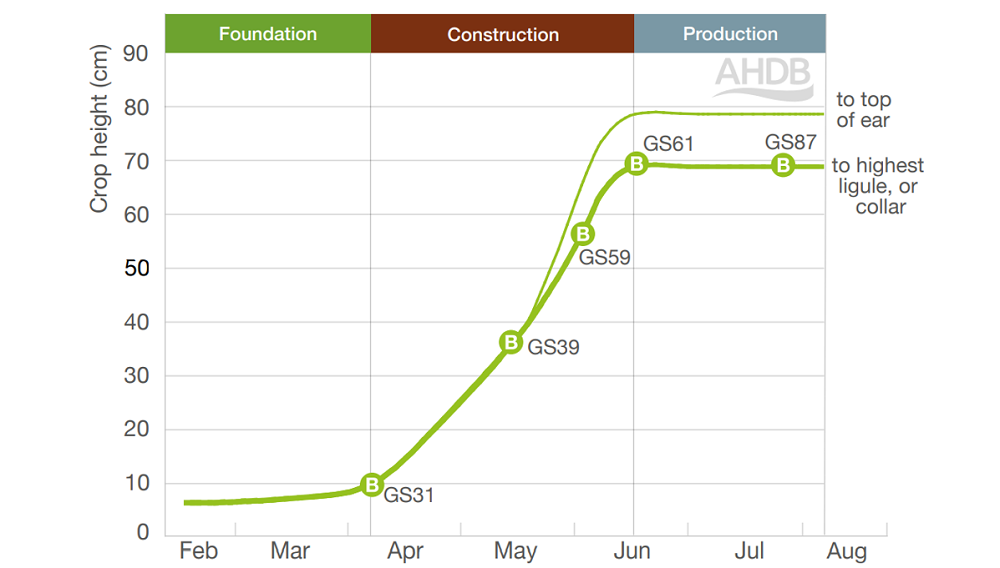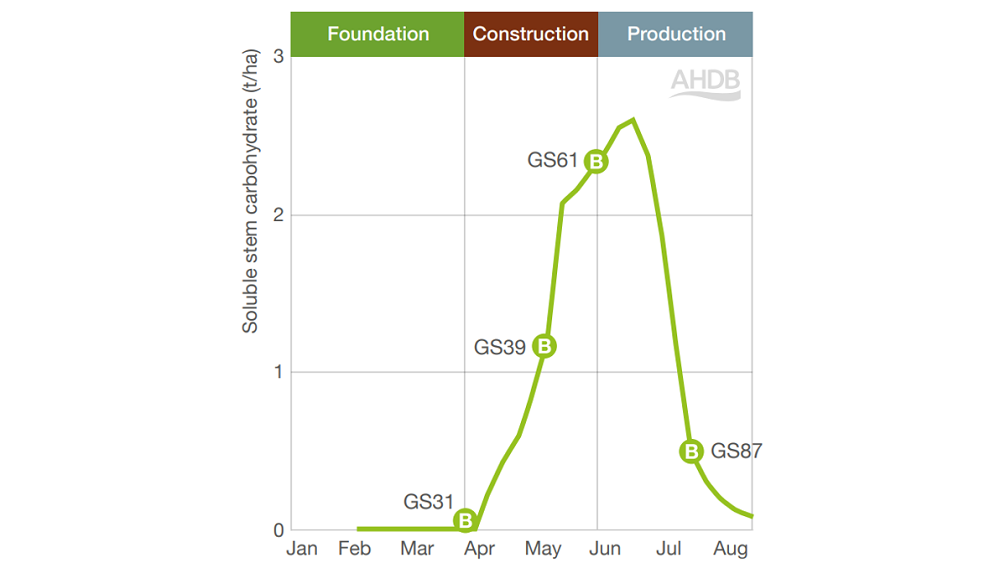- Home
- Knowledge library
- Measurement of stem extension and stem reserves in wheat
Measurement of stem extension and stem reserves in wheat
Careful management of cereals is essential to help the crop reach its optimum height and minimise lodging risks. Learn about the main-stem benchmarks and how stem reserves provide significant amounts of carbohydrates to filling grains.
Stem elongation and how to measure it
Benchmark: Five internodes measuring 69 cm, excluding ear
Varietal influence: High
Other influences: Sowing date, PGR use, N supply
Stem height is determined by extension of the last five or six internodes.
- A node is the point at which a leaf sheath is attached to a stem
- An internode is the section of stem between two adjacent nodes
Each internode starts to extend when the previous one has reached half its final length. The benchmark number of nodes in a wheat stem is four, giving five internodes. Crops sown earlier may have an extra internode and grow taller.
With a full PGR programme (applied during early and late stem extension), benchmark stem heights (to the highest ligule/collar or base of the ear) are:
- GS31 = 9 cm (related to leaf sheath length)
- GS39 = 34 cm (around 50% of final height)
- GS59 = 53 cm
- GS61 = 69 cm (final height)
Note: Without PGRs, crops can be as much as 20 cm taller.

How to measure stem elongation
Place a metre ruler on the ground. Measure stem height from soil level to the tip of the stem/collar of ear (the ear adds around 10 cm). Repeat for at least 10 shoots and take an average.
- Before GS39, measure the height of the main stem (largest stem)
- After GS39, measure any tiller
Lodging in cereals
In the UK, relatively widespread lodging of cereal crops occurs every few years. With potentially serious effects on yield and quality, it is important to understand and manage the risk to crops. Crop height is only one of several determinants of lodging risk in wheat.
An introduction to lodging in cereals
Stem carbohydrate storage and how to measure it
Accumulation of stem reserves (GS31 until early grain filling)
Varietal influence: High
Other influences: Shoot number
More assimilate – the product of the crop’s synthetic processes – is produced during the construction phase than is needed for structural tissues. The surplus is stored in stems, mainly as fructan sugar in the pith (central strand of spongy tissue located in stems):
- Topmost internode (peduncle) stores around 25% of the total
- Penultimate internode around 30% of the total
- Lower internodes around 45% of the total
Stem storage capacity is set by stem number and structure. Maximum capacity is often reached by late booting (GS47). However, reserves may be utilised during temporary shortages, caused by factors such as dull weather, before and after flowering.
The benchmark for soluble stem reserves at flowering is 2.3 t/ha.
An additional 0.4t/ha accumulates by early grain filling (sometimes, the maximum is reached before flowering) making the benchmark for maximum soluble stem reserves 2.7 t/ha.
Variety and growing conditions cause stem reserves to vary considerably – from <2 t/ha to >4 t/ha. Varietal differences may be due to both total stem weight and percentage of soluble material.
Recent UK varieties have 25–35% stem biomass as soluble reserves. Environmental differences in stem reserves commonly relate to differences in shoot/stem number.
Stem height does not reflect stem reserves, as taller stems have a greater proportion of structural materials that cannot be redistributed. Soluble stem carbohydrate is not affected by PGR applications.
Dry matter redistribution during grain filling
Benchmark: 2.9 t/ha, of which 1.9 t/ha soluble carbohydrate
Varietal influence: High
Carbohydrate reserves are the major part of the dry matter redistributed from stems and leaves during grain filling. Stem reserves contribute 20–50% of grain yield.
Redistribution of soluble reserves lasts from 26 days after flowering to the end of grain filling.
The loss in straw dry matter between flowering and harvest is 2.9 t/ha, comprising 1.9 t/ha soluble stem reserves and protein from leaves and stems.
Reserves contribute significantly to yield under all post-flowering conditions. Varieties with highest yield potential tend to be those that accumulate greatest amounts of stem soluble carbohydrate. Stem carbohydrate storage is not included in the Recommended List but wheat breeders may be able to provide information on varietal differences.
Stem reserves contribute similar amounts of assimilate in stressed or unstressed crops. However, because yields are reduced in stressed crops, reserves contribute a higher proportion.
By harvest, almost all stem reserves have been relocated to the grain or lost through respiration.
How to measure stem reserves
After stems are fully extended, pull up at least 10 stems (taking care not to break them) and remove leaf laminae, roots and ears. Dry the whole stems rapidly (at around 100°C), weigh them and send them for analysis by an appropriate laboratory. To determine the soluble stem reserves on an area basis, you will need to know the number of tillers in an area and multiply this by the Water Soluble Carbohydrates (WSC) per stem.

General growth benchmarks during stem extension
How to use benchmarks to assess cereal growth
|
GS30 |
31 March |
Ear at 1 cm |
|
Plants |
260/m2 |
70% of seeds sown |
|
Shoots |
941/m2 |
Tillering ceases when GAI >1 |
|
Roots |
0.4 t/ha; 12 km/m2 |
Little of the soil is fully rooted |
|
GAI |
1.6 |
Only enough to intercept 45% of light |
|
GS31 |
10 April |
First node detectable |
|
Shoots |
902/m2
|
Shoot numbers usually decrease from GS31 |
|
Three leaves yet to emerge |
28 April 9 May 19 May |
One leaf emerges every 122 degree days |
|
Roots |
0.5 t/ha; 15 km/m2 |
Roots now reach to about 1m depth |
|
N uptake |
81 kg/ha |
About 30% of final uptake |
|
GAI |
2.0 |
Only enough to intercept half the light |
|
Above-ground dry weight |
1.9 t/ha |
Only 10% of final dry weight |
|
Growth rate |
0.16 t/ha/day |
During the construction phase (GS31 to GS61) |
|
Height to top ligule |
9 cm |
Stem extension just starting |
|
GS39 |
19 May |
Flag leaf blade all visible |
|
Fertile shoots |
655/m2
|
Some young shoots are still dying |
|
Total leaf number on main shoot |
14 |
No further leaves emerge |
|
N uptake |
189 kg/ha |
Increasing by 2.5 kg/ha/day |
|
GAI |
6.2 |
Enough to intercept 95% of light |
|
Above-ground dry weight |
6.9 t/ha |
About 35% of maximum growth |
|
Height to top ligule |
34 cm |
Subsequent extension |
Topics:
Sectors:
Tags:

